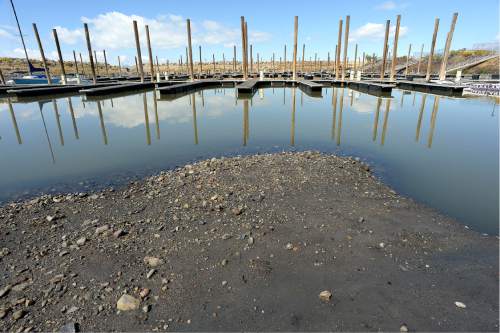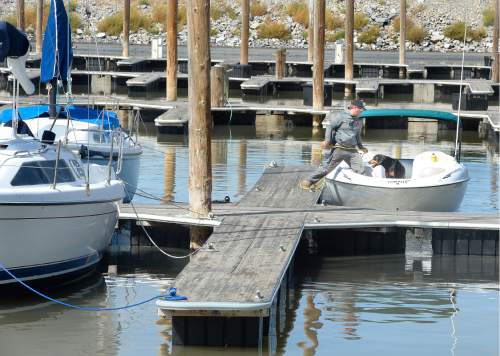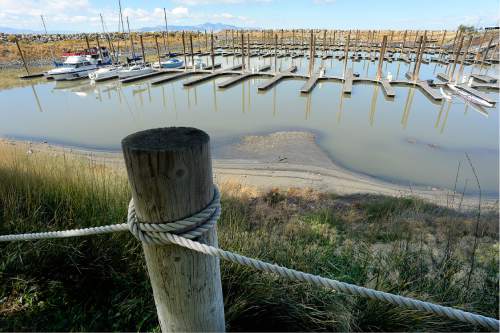This is an archived article that was published on sltrib.com in 2016, and information in the article may be outdated. It is provided only for personal research purposes and may not be reprinted.
In order to avoid an untimely drop in water levels, the Union Pacific Railroad has agreed to delay a planned breach of the company's causeway on the Great Salt Lake.
Union Pacific had planned to breach the causeway, which bisects the lake, sometime this fall, likely this month or next. But as of Friday, the company has agreed to delay its operations there until December.
Justin Jacobs, a spokesman for the railroad, said the delay was determined to be the best decision for all parties during talks this month with the Utah Division of Forestry, Fire and State Lands.
"Working together with the group," he said, "we came to the mutual decision that this was the best thing we can do at this time, given all the concerns."
Union Pacific has agreed to breach the causeway to replace two culverts that once allowed water to flow beneath it. Those culverts were filled beginning in 2011 because the culverts had sunk about 20 feet into the lake and were unstable.
When complete, the breach will be traversed by a bridge to facilitate rail traffic across the lake.
Earlier this year, however, it became apparent that because of increasingly low water levels in the lake, opening the breach this fall could have unintended consequences.
Since the loss of the culverts, the majority of the water that goes into the Great Salt Lake has been unable to reach the northern arm of the lake. Consequently, the level of the lake is higher on the southern side than on the northern side.
When the breach is opened, some of that extra water will flow onto the northern side, causing the water level on the southern side to drop an estimated 1.5 feet.
Should that happen now, members of the Great Salt Lake Yacht Club worried that water levels in the Great Salt Lake Marina would drop so low that the rescue boats that deploy from that location would be unable to access the lake.
Janet Robins, the Great Salt Lake Yacht Club commodore, said the deepest point of the marina is about 5 feet deep, and water depth at the mouth of the marina is 3.3 feet. Even the smallest of the rescue boats need at least 2.5 feet of water in order to operate, she said.
Robins said search and rescue crews have experienced difficulty in accessing the lake. The nicest, largest rescue boat at their disposal was pulled out of the marina two months ago, she said, when water levels dropped below what was required for the facility's operation. An older, smaller boat remained available, she said, until operating in shallow conditions caused its engine to fail.
"The boats can get in and out," she said, "but it's doing some serious damage."
State officials considered emergency dredging for the marina, but with the delay of the breach, those contingency plans are no longer necessary, said Nathan Schwebach, spokesman for the Utah Department of Natural Resources.
The state plans to dredge the marina early next year, he said, to remove silt that has accumulated.
While a focal point of the discussion, the search and rescue boats, which deploy an average of about 110 times per year, weren't the only concern that led to the delay of the breach.
Because the northern arm has been cut off from most of the freshwater inflow for the Great Salt Lake, the northern end of the lake has become much more saline than the southern end. And with water levels at or near record lows, many experts worried that an undiluted influx of saltwater into the south arm could kill off large quantities of brine shrimp in the lake. That, in turn, could cut into next year's harvest for the lake's brine shrimp industry, and could reduce the amount of food available for waterfowl this winter.
According to the Utah Division of Wildlife Resources, brine shrimp serve as the primary source of food for millions of birds that spend some part of the winter on the Great Salt Lake. For example, 4 million to 5 million eared grebes — more than half the entire population of that species — winters at the Great Salt Lake.
Winter precipitation is expected to replenish the lake in time for a December breach, though, according to the state Department of Natural Resources. State biologists will continue to evaluate conditions on the lake this winter to determine whether a longer delay is necessary.
"We are committed to maintaining a healthy Great Salt Lake. We know this delay is an inconvenience for Union Pacific and are appreciative of their leadership for supporting this effort," Brian Cottam, director of the Utah Division of Forestry, Fire and State Lands, said in a news release. "Postponing the breach allows impacts to be minimized and is in the best interest of the lake's ecology. With drought conditions and low lake levels persisting, the delay helps protect the lake's ecosystem and wildlife."
But Robins said that although the delay will buy the Great Salt Lake a little more time, it won't solve the problem in the long run.
"The underlying problem is not the breach," she said. "It's the massive water diversions that have affected the lake level so much."
Twitter: @EmaPen







